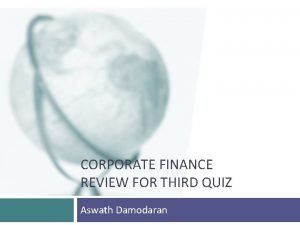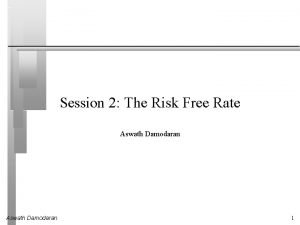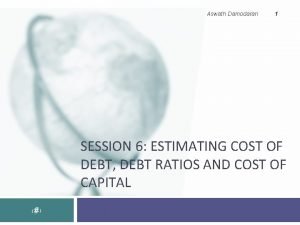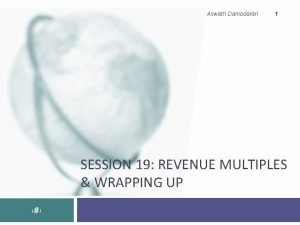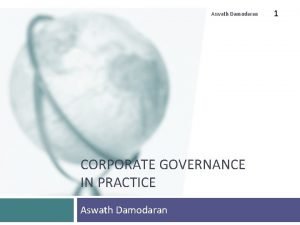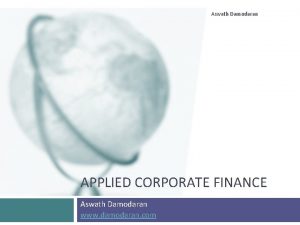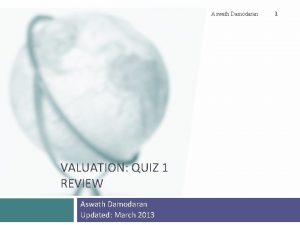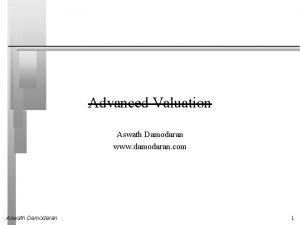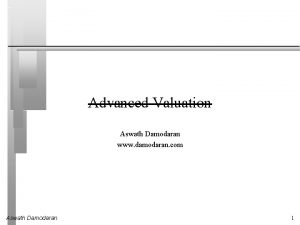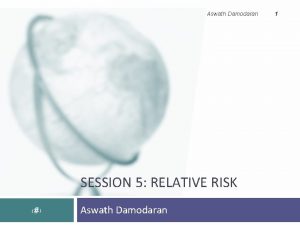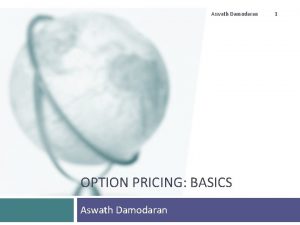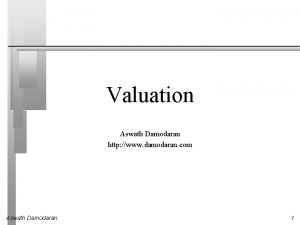CORPORATE FINANCE REVIEW FOR QUIZ 2 Aswath Damodaran











- Slides: 11

CORPORATE FINANCE REVIEW FOR QUIZ 2 Aswath Damodaran

Basic Skills Tested Can you compute the cost of capital for a project (rather than a firm)? How do you estimate the cost of equity for a project? What debt ratio should you use for a project? Can you estimate cash flows on an investment? What is the distinction between a firm and an equity cash flow? How does depreciation affect cash flows? What about working capital? What is the distinction between incremental and total cash flows? Can you convert cash flows into a measure of returns? Can you compute a return on capital (equity) and use it? Can you convert cash flows into a NPV? 2

Estimating cash flows The cash flows on a project can be estimated either to the either business or to just the equity investors in the business. If the cash flow is computed before debt payments (interest expenses and principal payments), it is to the entire business. If the cash flow is computed after debt payments (interest expenses and principal payments), it is to the equity investors. To measure cash flows, you have to go through a three step process: Start with the accounting earnings on the project, measured to either equity (net income) or the firm (operating income). Add back any non-cash charges/expenses. For example, depreciation and amortization are added back. Subtract out changes in non-cash working capital If you are estimating cash flows to equity, you will also net out any cash flows to debt (principal payments) or from debt (new debt raised) 3

Estimating Cash Flows: Example Nova Chemicals has provided you with the following estimates of operating income for a new investment, which is expected to have a three-year life and require an initial investment of $250 million. You are also told that the all of the allocated G&A is fixed (and will continue even if this project is rejected) and that you will have to invest 10% of the expected revenues each year in working capital at the start of the year. At the end of 3 years, you expect to get the remaining book value of your initial investment and the working capital back as salvage. Estimate the expected after-tax cash flows on this project, assuming a 40% marginal tax rate. 4

The Cash Flows 5

From cash flows to NPV The net present value of a project is the present value of the expected cash flows, discounted back at the “correct” discount rate. The correct discount rate for a project should follow three principles: It should reflect the risk of the project, not the risk of the business taking the project. It should be the cost of equity, if the cash flows are to equity, and the cost of capital, if the cash flows are to the business. It should be in the same currency as the cash flows 6

NPV: Example You have been asked to assess whether it makes sense for Geo. Tech Inc. to invest in a new telecomm investment. The initial investment is expected to be $ 60 million and the project is expected to generate income for the next 10 years. At the end of the tenth year, the project is expected to end, and you will be able to collect the remaining book value as salvage value. The cost of capital for Geo. Tech is 9% but this project is in a riskier business, with a cost of capital of 12%. 7

NPV: Solution Step 1: Compute the after-tax cash flow each year Step 2: Compute the net present value, using the project cost of capital NPV = -60 + $9. 9 (PV of annuity, 10 years, 12%)+10/1. 12^10 = -$0. 84 8

Cost of capital for a project: A quick review Restating the basic principle, the discount rate for a project should reflect the risk of the project and not the business taking the project. With that said, to estimate the cost of capital for a project, you need the following inputs: 1. 2. Beta: The beta for the project should reflect it’s exposure to market risk. It is usually estimated by looking at publicly traded firms in the same business that the project is in. Cost of debt/ debt ratio: If the project is a stand alone project that can carry its own debt, you should use the debt ratio & cost of debt that is appropriate for the project. If not, you should use the cost of debt & debt ratio for the firm. 9

Cost of capital for project: Example Solitaire Books is a publishing company that is considering expanding into educational services. Solitaire Books has a levered beta of 0. 80 and a debt to capital ratio (D/(D+E)) of 20%. T he unlevered beta for educational service companies is 1. 10 and Solitaire plans to use its existing debt ratio in funding the business. Solitaire’s effective tax rate is 30% but the marginal tax rate is 40%. Soliatire is rated A, and the default spread for A rated firms is 2%. Estimate the cost of capital you would use in doing a project analysis of the educational service investment. You can assume that the riskfree rate is 3% and the equity risk premium is 6% 10

The cost of capital for the project Step 1: Compute the beta for the project Unlevered beta for educational services = 1. 1 D/E ratio of existing business = 25% Marginal tax rate = 40% Levered beta for educational services= 1. 1 (1+ (1 -. 4)(. 25)) = 1. 265 Step 2: Compute the cost of equity & capital Cost of equity for educational services = 3% +1. 265(6%) = 10. 59% Pre-tax cost of debt = 3% + 2% =5. 00% After-tax cost of debt of educational services = 5% (1 -. 4) = 3. 00% Cost of capital for project = 10. 59% (. 8) + 3% (. 2) = 9. 0702% 11
